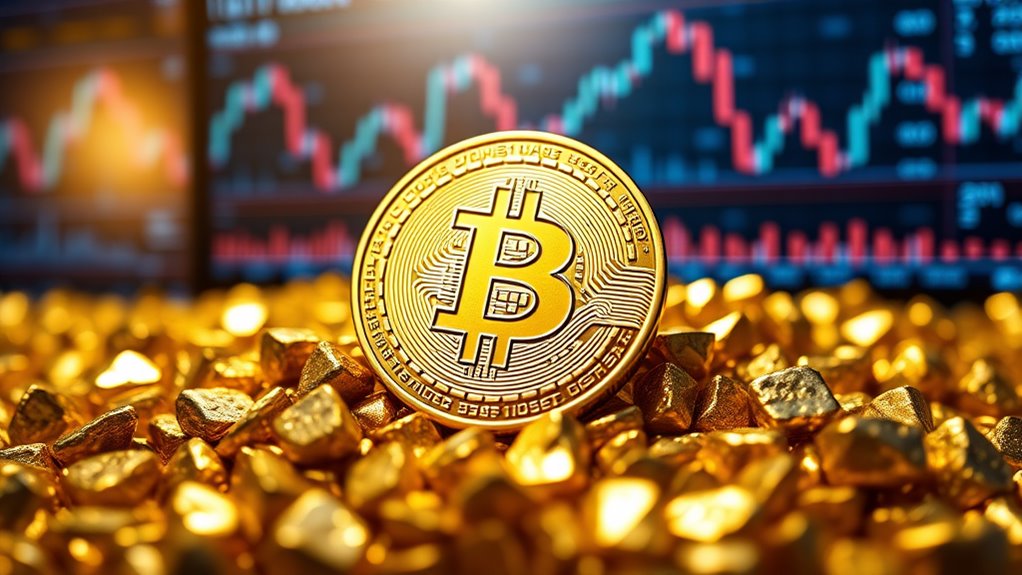
Bitcoin as an Investment: Is It Digital Gold?
Bitcoin is often referred to as “digital gold” due to its fixed supply of 21 million coins and a predictable release schedule. Unlike gold, which has been a stable store of value for centuries, Bitcoin offers a newer investment option with higher volatility. Its appeal is growing among institutional investors, who help stabilize prices and enhance market confidence. As both assets serve as inflation hedges, understanding their differences is essential to evaluating Bitcoin’s role in the investment landscape. More insights await.
Table of Contents
Key Takeaways
- Bitcoin’s fixed supply of 21 million coins creates scarcity, similar to gold, potentially driving value appreciation during high demand.
- Institutional adoption enhances Bitcoin’s legitimacy, promoting stability and increasing its perception as a reliable store of value.
- Unlike gold, Bitcoin’s price is highly volatile, yet its volatility has shown signs of decreasing as market capitalization grows.
- Technological advancements, such as layer-2 solutions, improve Bitcoin’s transaction efficiency, supporting its role as a viable digital asset.
- Bitcoin is increasingly recognized as “digital gold,” with its potential role in global finance being evaluated against traditional systems.
Understanding Bitcoin’s Scarcity and Value Proposition

Understanding Bitcoin’s scarcity is fundamental to grasping its value proposition. Bitcoin has a fixed supply of 21 million coins, limiting its availability and contributing to its perceived value.
This scarcity is reinforced by halving events, which occur every four years and reduce the rewards miners receive for validating transactions. As new Bitcoin becomes scarcer, its value may appreciate, especially during periods of high demand.
Unlike fiat currencies, which can be printed without limit, Bitcoin’s predictable supply schedule enhances its status as a store of value. This characteristic has attracted institutional investors who view Bitcoin as a unique asset class, further increasing its demand and solidifying its position in the investment landscape. Additionally, historical trends indicate that Bitcoin’s valuation growth has often coincided with broader market interest, reflecting its potential for significant returns.
Comparing Bitcoin and Gold as Inflation Hedges

In the context of inflation hedging, Bitcoin and gold present two distinct yet often compared options for investors. Gold has historically served as a reliable store of value, while Bitcoin offers a modern alternative with unique characteristics.
| Characteristics | Gold | Bitcoin |
|---|---|---|
| Historical Usage | Thousands of years | Approximately 15 years |
| Price Stability | Generally stable | Highly volatile |
| Supply Constraints | Geological limits | Hard-coded 21 million cap |
Both assets possess limited supply, yet their market behaviors differ greatly. Gold provides stability but limited growth potential, while Bitcoin, though riskier, may offer higher returns. Investors often find that a balanced approach, incorporating both, can mitigate risks associated with inflation. Additionally, Bitcoin’s potential as a long-term store of value is gaining recognition among investors looking for alternatives to traditional assets.
The Impact of Institutional Adoption on Bitcoin’s Stability

As institutional adoption of Bitcoin grows, its stability in the market is increasingly influenced by several key factors. Regulatory frameworks, institutional investment vehicles, and infrastructure advancements play significant roles in shaping Bitcoin’s environment.
- Unified regulatory approaches encourage transparency, enhancing market confidence.
- Exchange-traded funds (ETFs) simplify access, attracting significant capital inflows.
- Custodial services improve security and reliability, addressing investor concerns.
These elements collectively reduce uncertainty and volatility, fostering a more stable investment climate.
Collectively, these factors diminish market uncertainty and volatility, promoting a more stable environment for investment.
As institutions engage more with Bitcoin, their demand and participation are likely to influence overall market dynamics, potentially stabilizing prices. Furthermore, adhering to tax laws is crucial for compliance and may affect institutional investment strategies.
However, challenges such as compliance and security risks remain, necessitating ongoing attention from both regulators and institutional players.
Analyzing Bitcoin’s Volatility and Long-Term Growth Potential

Despite its reputation for extreme price fluctuations, Bitcoin’s volatility has shown signs of decreasing over recent years, particularly in 2023, when its realized volatility dropped considerably as the asset’s market capitalization expanded.
Historically, investors have often overestimated Bitcoin’s volatility, with implied volatility frequently surpassing actual realized volatility. While Bitcoin remains more volatile than traditional assets like stocks and gold, its Sharpe ratio from 2020 to early 2024 indicates that investors may receive adequate returns for the risks taken.
Additionally, the range-based realized volatility, which accounts for intraday price movements, reveals higher volatility than daily measurements suggest. This evolving volatility landscape may position Bitcoin as a viable long-term investment, potentially yielding substantial returns despite its inherent risks. Moreover, savvy traders can employ various strategies for taking advantage of BTC’s volatility, enhancing their potential returns in this dynamic market.
The Future of Bitcoin in a Digital Economy

Bitcoin’s role in the digital economy is increasingly recognized as it continues to evolve beyond its initial purpose as a decentralized currency.
Known as “digital gold,” Bitcoin is gaining traction for its limited supply and potential as a store of value. Its future prospects hinge on several key factors:
- Institutional Adoption: Growing interest from large financial institutions could bolster Bitcoin’s legitimacy and stability.
- Technological Advancements: Innovations like layer-2 solutions enhance transaction efficiency and scalability, making Bitcoin more accessible.
- Mainstream Integration: As businesses and countries adopt Bitcoin, its acceptance as a payment method can solidify its role in the economy.
Additionally, Bitcoin’s role in global finance is being increasingly evaluated as a potential alternative to traditional financial systems.
These elements suggest that Bitcoin may play a significant part in shaping the future landscape of digital finance.
Frequently Asked Questions
How Do I Buy and Store Bitcoin Securely?
To buy and store Bitcoin securely, one should choose reputable exchanges, utilize hardware wallets for storage, enable two-factor authentication, and guarantee compliance with local regulations while maintaining secure internet connections during transactions.
What Are the Tax Implications of Investing in Bitcoin?
The tax implications of investing in Bitcoin include treating it as property, triggering capital gains taxes, and requiring detailed record-keeping. Tax rates vary based on holding duration, and taxpayers bear the reporting responsibility.
Can I Use Bitcoin for Everyday Purchases?
While Bitcoin can technically facilitate everyday purchases, its slow transaction speed and limited merchant acceptance hinder practicality. Most users prefer it for speculation rather than as a reliable payment method, reflecting ongoing adoption challenges.
What Are the Risks of Bitcoin Mining?
Bitcoin mining carries risks including environmental degradation, technological failures, economic volatility, and regulatory uncertainties. High energy consumption contributes to pollution, while fluctuating prices and lack of regulation challenge miners’ profitability and operational sustainability.
How Does Bitcoin Impact the Environment?
In a hypothetical scenario, a Bitcoin mining operation in a rural area greatly increases local air pollution, affecting residents’ health. Overall, Bitcoin mining contributes to high energy consumption, greenhouse gas emissions, and substantial environmental degradation.
Conclusion
To sum up, Bitcoin stands at a crossroads, shimmering like a digital phoenix in a landscape dominated by traditional investments. Its scarcity mirrors that of gold, while its potential as an inflation hedge captures the imagination of many. Institutional adoption may stabilize its wild fluctuations, yet questions about long-term growth persist. As the digital economy evolves, Bitcoin’s role may become as essential as gold’s once was, transforming the future of finance in ways yet to be fully realized.




